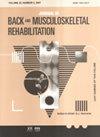Low back pain and kinesiophobia in pregnant women.
IF 1.4
4区 医学
Q3 ORTHOPEDICS
引用次数: 0
Abstract
BACKGROUND During pregnancy, many pregnant women experience lumbopelvic pain due to mechanical, systemic, and hormonal reasons and this pain and fear of movement (kinesiophobia) causes daily life limitations. OBJECTIVE To examine low back pain (LBP), kinesiophobia, disability, and related conditions that develop together during pregnancy. METHODS The was a cross-sectional and analytical study. The presence, severity, and duration of pain in the lumbopelvic region were questioned. Postpartum LBP was evaluated using a self-administered questionnaire, disability using the Oswestry Disability Index (ODI), pain intensity using a visual analog scale (VAS), physical activity levels using the physical activity level during pregnancy questionnaire and the international physical activity questionnaire short form, and kinesiophobia was evaluated using the Tampa Scale for Kinesiophobia. RESULTS The study comprised 120 pregnant women with a mean age of 27.4 ± 6.1 years. It was observed that 42.3% of the pregnant had LBP (n= 69). The mean body mass index (BMI) was 73.6 ± 16.2 kg/m2, and the mean VAS score was 5.5 ± 2 cm. When we divided the group according to the presence of LBP, age (p= 0.49), gestational week (p= 0.75), and gravida (p= 0.81) were similar. BMI (p= 0.038) and ODI scores (p< 0.001) were higher in the group with LBP. CONCLUSION LBP in pregnant women has a higher frequency than in the normal population, regardless of age, gestational week, and gravida. Obesity appears to be a risk factor for LBP and increases disability. Kinesiophobia in pregnant women is significantly associated with obesity and disability. Unless there are contraindications, a physically active pregnancy process and regular exercise should be recommend.孕妇的腰痛和运动恐惧症
背景在怀孕期间,由于机械性、全身性和荷尔蒙等原因,许多孕妇会感到腰椎疼痛,这种疼痛和对运动的恐惧(运动恐惧症)会导致日常生活受到限制。该研究采用横断面分析法,对腰椎疼痛的存在、严重程度和持续时间进行了调查。产后腰背痛采用自制问卷进行评估,残疾程度采用奥斯韦特里残疾指数(Oswestry Disability Index,ODI),疼痛强度采用视觉模拟量表(VAS),体力活动水平采用孕期体力活动水平问卷和国际体力活动问卷简表,运动恐惧症采用坦帕运动恐惧症量表(Tampa Scale for Kinesiophobia)进行评估。据观察,42.3%的孕妇患有枸杞痛(69 人)。平均体重指数(BMI)为 73.6 ± 16.2 kg/m2,平均 VAS 评分为 5.5 ± 2 cm。根据枸杞痛的存在情况进行分组时,年龄(p= 0.49)、孕周(p= 0.75)和孕产妇(p= 0.81)相似。结论无论年龄、孕周和胎次,孕妇枸杞痛的发生率都高于正常人群。肥胖似乎是枸杞多糖症的一个危险因素,并会增加残疾程度。孕妇运动恐怖症与肥胖和残疾有很大关系。除非有禁忌症,否则应建议孕妇在怀孕期间积极参加体育锻炼,并定期进行运动。
本文章由计算机程序翻译,如有差异,请以英文原文为准。
求助全文
约1分钟内获得全文
求助全文
来源期刊
CiteScore
2.70
自引率
0.00%
发文量
194
审稿时长
6 months
期刊介绍:
The Journal of Back and Musculoskeletal Rehabilitation is a journal whose main focus is to present relevant information about the interdisciplinary approach to musculoskeletal rehabilitation for clinicians who treat patients with back and musculoskeletal pain complaints. It will provide readers with both 1) a general fund of knowledge on the assessment and management of specific problems and 2) new information considered to be state-of-the-art in the field. The intended audience is multidisciplinary as well as multi-specialty.
In each issue clinicians can find information which they can use in their patient setting the very next day.

 求助内容:
求助内容: 应助结果提醒方式:
应助结果提醒方式:


